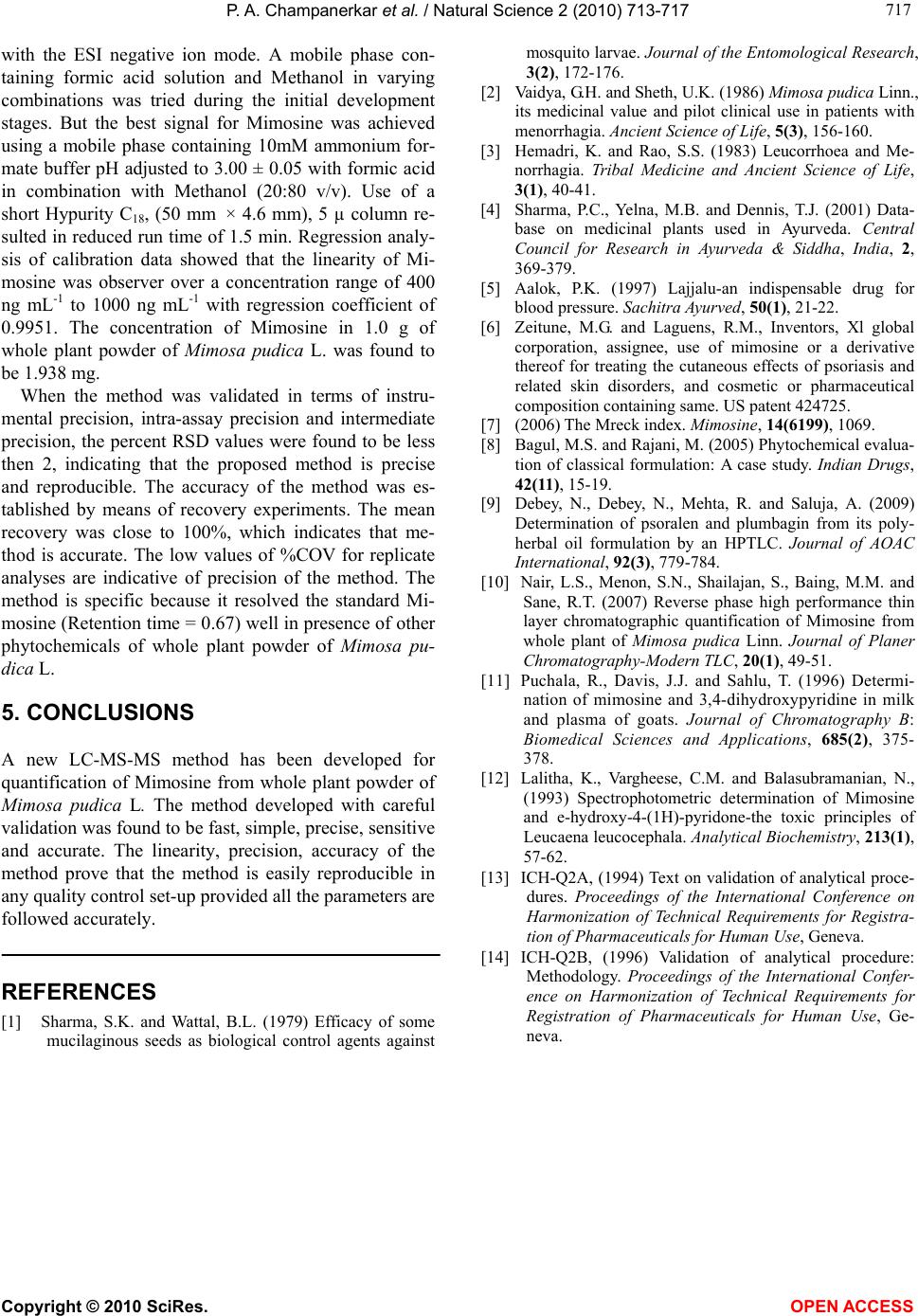
P. A. Champanerkar et al. / Natural Science 2 (2010) 713-717
Copyright © 2010 SciRes. OPEN ACCESS
717
717
with the ESI negative ion mode. A mobile phase con-
taining formic acid solution and Methanol in varying
combinations was tried during the initial development
stages. But the best signal for Mimosine was achieved
using a mobile phase containing 10mM ammonium for-
mate buffer pH adjusted to 3.00 ± 0.05 with formic acid
in combination with Methanol (20:80 v/v). Use of a
short Hypurity C18, (50 mm × 4.6 mm), 5 µ column re-
sulted in reduced run time of 1.5 min. Regression analy-
sis of calibration data showed that the linearity of Mi-
mosine was observer over a concentration range of 400
ng mL-1 to 1000 ng mL-1 with regression coefficient of
0.9951. The concentration of Mimosine in 1.0 g of
whole plant powder of Mimosa pudica L. was found to
be 1.938 mg.
When the method was validated in terms of instru-
mental precision, intra-assay precision and intermediate
precision, the percent RSD values were found to be less
then 2, indicating that the proposed method is precise
and reproducible. The accuracy of the method was es-
tablished by means of recovery experiments. The mean
recovery was close to 100%, which indicates that me-
thod is accurate. The low values of %COV for replicate
analyses are indicative of precision of the method. The
method is specific because it resolved the standard Mi-
mosine (Retention time = 0.67) well in presence of other
phytochemicals of whole plant powder of Mimosa pu-
dica L.
5. CONCLUSIONS
A new LC-MS-MS method has been developed for
quantification of Mimosine from whole plant powder of
Mimosa pudica L. The method developed with careful
validation was found to be fast, simple, precise, sensitive
and accurate. The linearity, precision, accuracy of the
method prove that the method is easily reproducible in
any quality control set-up provided all the parameters are
followed accurately.
REFERENCES
[1] Sharma, S.K. and Wattal, B.L. (1979) Efficacy of some
mucilaginous seeds as biological control agents against
mosquito larvae. Journal of the Entomological Research,
3(2), 172-176.
[2] Vaidya, G.H. and Sheth, U.K. (1986) Mimosa pudica Linn.,
its medicinal value and pilot clinical use in patients with
menorrhagia. Ancient Science of Life, 5(3), 156-160.
[3] Hemadri, K. and Rao, S.S. (1983) Leucorrhoea and Me-
norrhagia. Tribal Medicine and Ancient Science of Life,
3(1), 40-41.
[4] Sharma, P.C., Yelna, M.B. and Dennis, T.J. (2001) Data-
base on medicinal plants used in Ayurveda. Central
Council for Research in Ayurveda & Siddha, India, 2,
369-379.
[5] Aalok, P.K. (1997) Lajjalu-an indispensable drug for
blood pressure. Sachitra Ayurved, 50(1), 21-22.
[6] Zeitune, M.G. and Laguens, R.M., Inventors, Xl global
corporation, assignee, use of mimosine or a derivative
thereof for treating the cutaneous effects of psoriasis and
related skin disorders, and cosmetic or pharmaceutical
composition containing same. US patent 424725.
[7] (2006) The Mreck index. Mimosine, 14(6199), 1069.
[8] Bagul, M.S. and Rajani, M. (2005) Phytochemical evalua-
tion of classical formulation: A case study. Indian Drugs,
42(11), 15-19.
[9] Debey, N., Debey, N., Mehta, R. and Saluja, A. (2009)
Determination of psoralen and plumbagin from its poly-
herbal oil formulation by an HPTLC. Journal of AOAC
International, 92(3), 779-784.
[10] Nair, L.S., Menon, S.N., Shailajan, S., Baing, M.M. and
Sane, R.T. (2007) Reverse phase high performance thin
layer chromatographic quantification of Mimosine from
whole plant of Mimosa pudica Linn. Journal of Planer
Chromatography-Modern TLC, 20(1), 49-51.
[11] Puchala, R., Davis, J.J. and Sahlu, T. (1996) Determi-
nation of mimosine and 3,4-dihydroxypyridine in milk
and plasma of goats. Journal of Chromatography B:
Biomedical Sciences and Applications, 685(2), 375-
378.
[12] Lalitha, K., Vargheese, C.M. and Balasubramanian, N.,
(1993) Spectrophotometric determination of Mimosine
and e-hydroxy-4-(1H)-pyridone-the toxic principles of
Leucaena leucocephala. Analytical Biochemistry, 213(1),
57-62.
[13] ICH-Q2A, (1994) Text on validation of analytical proce-
dures. Proceedings of the International Conference on
Harmonization of Technical Requirements for Registra-
tion of Pharmaceuticals for Human Use, Geneva.
[14] ICH-Q2B, (1996) Validation of analytical procedure:
Methodology. Proceedings of the International Confer-
ence on Harmonization of Technical Requirements for
Registration of Pharmaceuticals for Human Use, Ge-
neva.